The Chiefs
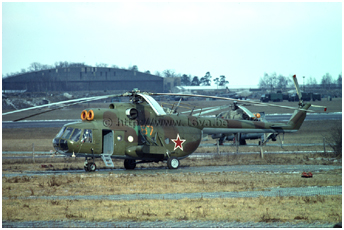
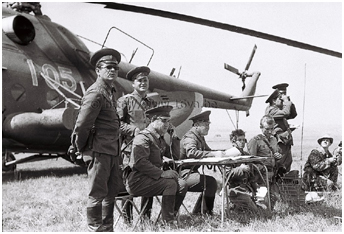 The Soviet forces relied widely on airborne command posts, whether they were airplanes
(see > Airborne Command Posts) or helicopters.
On-board equipment included means of ordinary radiotelephony, high-speed secure communications and radio-relay.
Airborne command posts ensured continuity and stability of radio transmissions, for example when moving a command post or
during the movement of troops. Contact with units cut off from the main forces could also be established and the chain of
command maintained. The range and reliability of communications were increased in a timely manner, inter alia, before a
nuclear attack or during an offensive, when an intense exchange of information and commands was necessary. Helicopters
allowed Army commanders to directly control their troops on the battlefield in a rapidly changing situation. Control was
then performed from the ground, once the helicopter had landed on a site permitting battlefield observation.
The Soviet forces relied widely on airborne command posts, whether they were airplanes
(see > Airborne Command Posts) or helicopters.
On-board equipment included means of ordinary radiotelephony, high-speed secure communications and radio-relay.
Airborne command posts ensured continuity and stability of radio transmissions, for example when moving a command post or
during the movement of troops. Contact with units cut off from the main forces could also be established and the chain of
command maintained. The range and reliability of communications were increased in a timely manner, inter alia, before a
nuclear attack or during an offensive, when an intense exchange of information and commands was necessary. Helicopters
allowed Army commanders to directly control their troops on the battlefield in a rapidly changing situation. Control was
then performed from the ground, once the helicopter had landed on a site permitting battlefield observation.

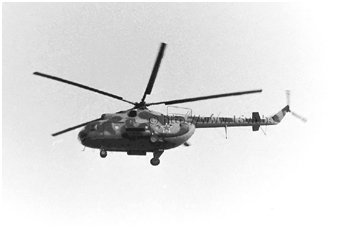 These helicopters also acted as relays between a distant headquarters (Wünsdorf) and a field CP. In such a situation,
it was then necessary to fly at an altitude of about 200 meters. In this regard, a huge buried communications complex with callsign
"Ranet" (Rennet) was located at the GHQ in Zossen-Wünsdorf. This site known as the "Zeppelin Bunker" (it can be visited today) was
formerly the Wehrmacht General Staff communication center. However, the Soviet complex also included smaller essential dispersed sites.
Thus, the ORRUS Center (Radio-Relay Communications Support Center) using the callsign "Trigger" (Trigger - word identical in Russian and in English)
was located three kilometers north of "Ranet" in the woods on the outskirts of the Wünsdorf Range. A dozen or so people served at
"Trigger." This site was part of the communication chain between the GHQ and moving vehicles or field CPs. Among the different electronic equipment
present on the site was a R-409 radio-relay set for communications with the airborne command posts, whether they were planes or helicopters.
These helicopters also acted as relays between a distant headquarters (Wünsdorf) and a field CP. In such a situation,
it was then necessary to fly at an altitude of about 200 meters. In this regard, a huge buried communications complex with callsign
"Ranet" (Rennet) was located at the GHQ in Zossen-Wünsdorf. This site known as the "Zeppelin Bunker" (it can be visited today) was
formerly the Wehrmacht General Staff communication center. However, the Soviet complex also included smaller essential dispersed sites.
Thus, the ORRUS Center (Radio-Relay Communications Support Center) using the callsign "Trigger" (Trigger - word identical in Russian and in English)
was located three kilometers north of "Ranet" in the woods on the outskirts of the Wünsdorf Range. A dozen or so people served at
"Trigger." This site was part of the communication chain between the GHQ and moving vehicles or field CPs. Among the different electronic equipment
present on the site was a R-409 radio-relay set for communications with the airborne command posts, whether they were planes or helicopters.
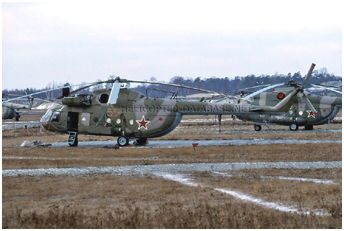
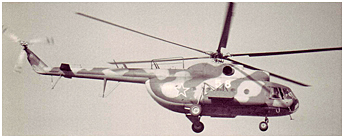 The first helicopters transformed into airborne command posts were the Mi-4KK and -KU (see > The Mi-4).
They fulfilled their missions at division level. In 1972, it was the turn of the Mi-6 to perform this task at the combined-arms army and air army level first
with the Mi-6VKP version, and later the Mi-6AYa (Mi-22) in 1975 (see > The Mi-6). The Mi-8T were no
exception and the first examples of a command version - at the division level - were modified in maintenance centers in the early 1970s.
This new version designated Mi-8VzPU (Vozdushnyy Punkt Upravleniya - airborne control post) was often called Mi-8VKP (Vozdushnyy Kommandnyy Punkt
- airborne command post) in the units. The designation Mi-8BUS (Bortovyye Uzly Svyazi - communication centers/nodes
(1)) has also been reported.
The first helicopters transformed into airborne command posts were the Mi-4KK and -KU (see > The Mi-4).
They fulfilled their missions at division level. In 1972, it was the turn of the Mi-6 to perform this task at the combined-arms army and air army level first
with the Mi-6VKP version, and later the Mi-6AYa (Mi-22) in 1975 (see > The Mi-6). The Mi-8T were no
exception and the first examples of a command version - at the division level - were modified in maintenance centers in the early 1970s.
This new version designated Mi-8VzPU (Vozdushnyy Punkt Upravleniya - airborne control post) was often called Mi-8VKP (Vozdushnyy Kommandnyy Punkt
- airborne command post) in the units. The designation Mi-8BUS (Bortovyye Uzly Svyazi - communication centers/nodes
(1)) has also been reported.
Let's attempt to explain this plethora of designations. These helicopters included a command compartment (VzPU or VKP) and one or more communication nodes (BUS),
which explains these different ways of designating a single helicopter. These terms were therefore not specific to a precise type of onboard hardware such
as an "X" communication suite.
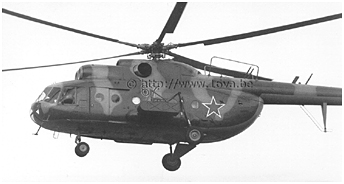
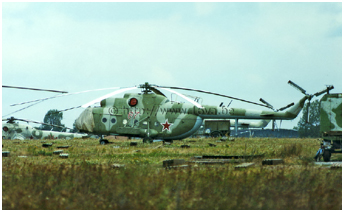 The "Hip-D" as it was known in the west differed from the Mi-8T by two inverted U-shaped tubular dorsal antennas and V-shaped double mast antennas located in lieu
of the usual Doppler system housing installed under the tail boom. Two large parallelepipedic-shaped containers were attached under the lateral outriggers. The fuel
tanks were of standard capacity (745 and 680 liters). Equipment proven by operation aboard the MI-6VKP was used aboard Mi-8VzPUs. Since it was assumed that radio
stations would operate separately, electromagnetic compatibility with possible adverse mutual influence was not considered. A bulkhead located after the side access
door separated the aft cargo hold. There was a large working table where the tactical situation was reported (VzPU), while three narrow compartments
occupied by radio operators were located to its right. Another operator was sitting behind, separated by another bulkhead. The communications suite (BUS) included
the following radios:
The "Hip-D" as it was known in the west differed from the Mi-8T by two inverted U-shaped tubular dorsal antennas and V-shaped double mast antennas located in lieu
of the usual Doppler system housing installed under the tail boom. Two large parallelepipedic-shaped containers were attached under the lateral outriggers. The fuel
tanks were of standard capacity (745 and 680 liters). Equipment proven by operation aboard the MI-6VKP was used aboard Mi-8VzPUs. Since it was assumed that radio
stations would operate separately, electromagnetic compatibility with possible adverse mutual influence was not considered. A bulkhead located after the side access
door separated the aft cargo hold. There was a large working table where the tactical situation was reported (VzPU), while three narrow compartments
occupied by radio operators were located to its right. Another operator was sitting behind, separated by another bulkhead. The communications suite (BUS) included
the following radios:
- R-111: wide band LVHF radio for command vehicles (ground troops) >
Link 1/
Link 2.
- R-130 (or R-140): low-power HF radio for fixed and mobile use >
Link 1 /
Link 2.
- R-409: VHF/UHF radio-relay > Link 1 /
Link 2.
- R-802: VHF air radio >
Link 1 /
Link 2.
- R-831: mid-range VHF air radio (air-to-ground communications - there also was a ground version mounted on a ZIL-130 chassis)
> Link.
- R-847: telephony and radiotelegraphy short wave air radio >
Link.
On some transmitters, several channels could be connected simultaneously on a single frequency (multiplexing or teleconferencing). The equipment at that time still
largely worked with vacuum tubes and consequently was heavy and bulky. It was thus necessary to mount some of the batteries inside external pods attached to the weapon outriggers.
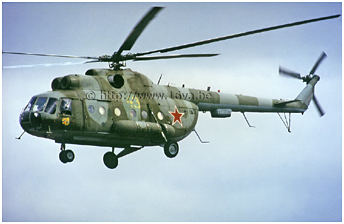
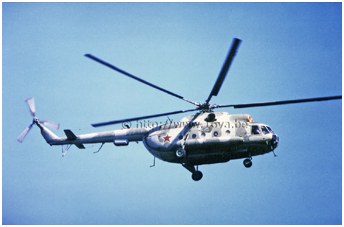 But the specificity of command at the divisional level sometimes required other systems and the Soviet Army's communications equipment became more sophisticated.
So, a new dedicated airborne command post version of the Mi-8 was ordered by the Ministry of Defense. The new helicopter designed in 1976 was designated Mi-8IV because
it carried a communication suite called "Ivolga" (Oriole). However, it went into production at Kazan' Plant n°387 in 1977 under the Mi-9 designation or "Hip-G" for NATO.
As a successor to the Mi-8VzPU, it was logically intended for the command link of motorized rifle, tank and air divisions. This helicopter was recognizable by its
cristiform antennas located under the tail boom and the left clamshell door. A straight antenna was attached to the right clamshell door. A dipole antenna nested inside two
long ventral fairings was fixed under the fuselage. Another electrically operated antenna was fixed under the right forward part of the fuselage. It was stowed in a horizontal
position and could swing to the vertical position once in flight. The clamshell doors of the aft cargo compartment were identical to those of the Mi-8PS already described; they
were narrower, and their hinge axis was vertical instead of angled.
But the specificity of command at the divisional level sometimes required other systems and the Soviet Army's communications equipment became more sophisticated.
So, a new dedicated airborne command post version of the Mi-8 was ordered by the Ministry of Defense. The new helicopter designed in 1976 was designated Mi-8IV because
it carried a communication suite called "Ivolga" (Oriole). However, it went into production at Kazan' Plant n°387 in 1977 under the Mi-9 designation or "Hip-G" for NATO.
As a successor to the Mi-8VzPU, it was logically intended for the command link of motorized rifle, tank and air divisions. This helicopter was recognizable by its
cristiform antennas located under the tail boom and the left clamshell door. A straight antenna was attached to the right clamshell door. A dipole antenna nested inside two
long ventral fairings was fixed under the fuselage. Another electrically operated antenna was fixed under the right forward part of the fuselage. It was stowed in a horizontal
position and could swing to the vertical position once in flight. The clamshell doors of the aft cargo compartment were identical to those of the Mi-8PS already described; they
were narrower, and their hinge axis was vertical instead of angled.
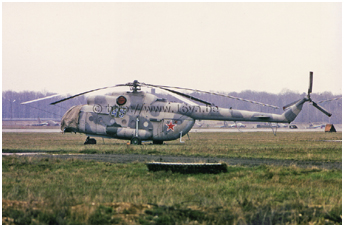
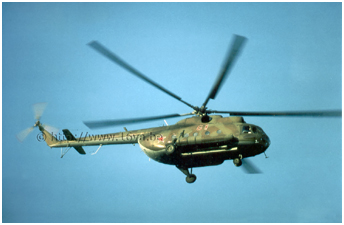 An access door was cut in the center of the two clamshell doors and a small light was installed under the tail boom to illuminate the exit. The fuel tanks were
of the higher-capacity type. The Mi-9 deployed in the GDR came in different configurations (2). The first models had no Doppler
container, while some helicopters were later equipped with one. Other modernized Mi-9s were equipped with ASO-2V flare launchers mounted on the fuselage sides between the last
porthole and the cargo doors. In the latter case, a support for a SOEP-V1A Lipa infrared jammer also was mounted. Unlike its predecessor, the internal layout of the Mi-9
was designed specifically for the communication suite.
An access door was cut in the center of the two clamshell doors and a small light was installed under the tail boom to illuminate the exit. The fuel tanks were
of the higher-capacity type. The Mi-9 deployed in the GDR came in different configurations (2). The first models had no Doppler
container, while some helicopters were later equipped with one. Other modernized Mi-9s were equipped with ASO-2V flare launchers mounted on the fuselage sides between the last
porthole and the cargo doors. In the latter case, a support for a SOEP-V1A Lipa infrared jammer also was mounted. Unlike its predecessor, the internal layout of the Mi-9
was designed specifically for the communication suite.
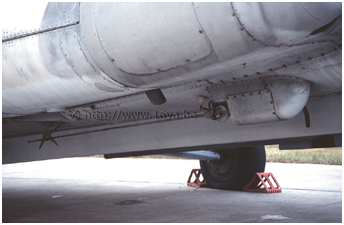
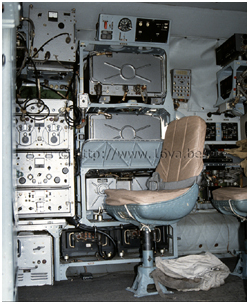 It was essentilly composed of a R-856MB HF radio (air and ground communications) that worked with the cristiform antennas,
a R-802VYa VHF aviation radio, a R-832M Evkalipt (Eucalyptus)
VHF/UHF aviation radio and two R-111 radios used to communicate with ground troops in the HF and VHF bands. These operated in flight using the swinging antenna located under
the fuselage, or on the ground using an antenna mounted on a 11-meter-high mast (the sides of the Mi-9 fuselage included plugs to connect ground antennas).
The onboard complex also included two R-886 receivers (D and E) and a R-405P radio-relay set.
The latter could only be used on the ground, with an antenna attached to a mast erected to a height of 16.5 meters. The communication aggregate was designed for simple or
complex communications (multiplexing), with voice or telegraphy. Two T-817 Yakhta (Yacht) sets made it possible
to encrypt voice communications, while an M-125 Fialka (Violet) coding machine, a distant descendant of the
German Enigma, allowed the sending and receiving of encoded messages via a P-590A module. Three tape recorders also were on board.
It was essentilly composed of a R-856MB HF radio (air and ground communications) that worked with the cristiform antennas,
a R-802VYa VHF aviation radio, a R-832M Evkalipt (Eucalyptus)
VHF/UHF aviation radio and two R-111 radios used to communicate with ground troops in the HF and VHF bands. These operated in flight using the swinging antenna located under
the fuselage, or on the ground using an antenna mounted on a 11-meter-high mast (the sides of the Mi-9 fuselage included plugs to connect ground antennas).
The onboard complex also included two R-886 receivers (D and E) and a R-405P radio-relay set.
The latter could only be used on the ground, with an antenna attached to a mast erected to a height of 16.5 meters. The communication aggregate was designed for simple or
complex communications (multiplexing), with voice or telegraphy. Two T-817 Yakhta (Yacht) sets made it possible
to encrypt voice communications, while an M-125 Fialka (Violet) coding machine, a distant descendant of the
German Enigma, allowed the sending and receiving of encoded messages via a P-590A module. Three tape recorders also were on board.
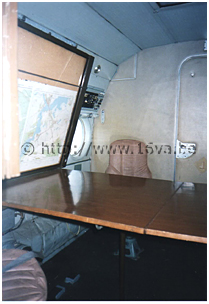 The interior layout consisted of four distinct parts: the cockpit; a communications center where three operators dealt with the various electronic equipment (BUS);
a command post with armchairs, reading tables for maps and a storage cabinet with secure locks (VzPU) isolated from the previous compartment by a bulkhead; and finally,
a cargo hold for the material isolated from the command compartment by another bulkhead. The latter compartment included, in addition to some radios, the telescopic antenna masts
and an AI-8 mobile power unit intended to provide the necessary electrical power when the Mi-9 was used as a ground CP. This APU could also be used to start the helicopter engines,
but in practice, it was often left behind because it weighted up to 300 kg.
The air-conditioned cargo hold could accommodate up to six people. A DP-3B dosimeter was part of the onboard suite. As was very
likely the case for the crews of the other specialized versions, the Mi-9's flight crew did not know anything about the equipment they were carrying.
The interior layout consisted of four distinct parts: the cockpit; a communications center where three operators dealt with the various electronic equipment (BUS);
a command post with armchairs, reading tables for maps and a storage cabinet with secure locks (VzPU) isolated from the previous compartment by a bulkhead; and finally,
a cargo hold for the material isolated from the command compartment by another bulkhead. The latter compartment included, in addition to some radios, the telescopic antenna masts
and an AI-8 mobile power unit intended to provide the necessary electrical power when the Mi-9 was used as a ground CP. This APU could also be used to start the helicopter engines,
but in practice, it was often left behind because it weighted up to 300 kg.
The air-conditioned cargo hold could accommodate up to six people. A DP-3B dosimeter was part of the onboard suite. As was very
likely the case for the crews of the other specialized versions, the Mi-9's flight crew did not know anything about the equipment they were carrying.
The Mi-9 had not completely replaced the Mi-8VzPU when the Berlin Wall fell. Both versions of these airborne command posts were then assigned to the separate combat and control helicopter squadrons
and regiments. A few Mi-9 also were assigned to the 113.OSAE and the aviation division HQs.
notes
(1)
One sometimes finds the BUS and the VUS (Vspomogatel'nyy Uzel Svyazi - auxiliary communications node) designations in the literature.
The classic confusion with the Cyrillic letter "B" transliterated by the Latin character "V" seems topical.
However, articles in the Russian language also mention the term BUS for which there are two different expansions:
- Bortovoy Uzel Svyazi or onboard communications node
- Boevogo Upravleniya i Svyazi or combat control and communications
We will stick to the BUS term as described in the text of this article as found in a document that seems reliable. We will not fail to update this article if
necessary.
(2)
Mi-9 observed in Russia and Czechoslovakia were not necessarily equipped with the same radios and antennas as those described in this article.
 |
The Mi-8 < Part 1 | < Part 2 | < Part 3 | < Part 4 | > Part 6 | > Part 7 |
 |
Plan du site - Sitemap |  |
